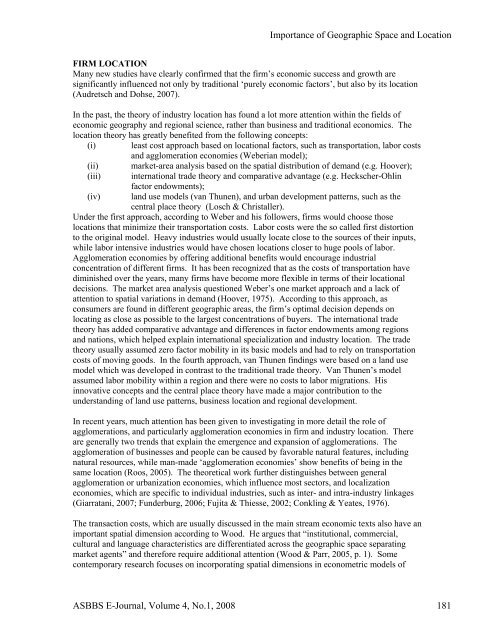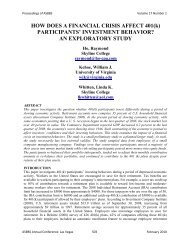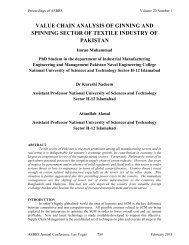stock repurchase announcements: a test of market ... - Asbbs.org
stock repurchase announcements: a test of market ... - Asbbs.org
stock repurchase announcements: a test of market ... - Asbbs.org
Create successful ePaper yourself
Turn your PDF publications into a flip-book with our unique Google optimized e-Paper software.
Importance <strong>of</strong> Geographic Space and Location<br />
FIRM LOCATION<br />
Many new studies have clearly confirmed that the firm’s economic success and growth are<br />
significantly influenced not only by traditional ‘purely economic factors’, but also by its location<br />
(Audretsch and Dohse, 2007).<br />
In the past, the theory <strong>of</strong> industry location has found a lot more attention within the fields <strong>of</strong><br />
economic geography and regional science, rather than business and traditional economics. The<br />
location theory has greatly benefited from the following concepts:<br />
(i) least cost approach based on locational factors, such as transportation, labor costs<br />
and agglomeration economies (Weberian model);<br />
(ii) <strong>market</strong>-area analysis based on the spatial distribution <strong>of</strong> demand (e.g. Hoover);<br />
(iii) international trade theory and comparative advantage (e.g. Heckscher-Ohlin<br />
factor endowments);<br />
(iv) land use models (van Thunen), and urban development patterns, such as the<br />
central place theory (Losch & Christaller).<br />
Under the first approach, according to Weber and his followers, firms would choose those<br />
locations that minimize their transportation costs. Labor costs were the so called first distortion<br />
to the original model. Heavy industries would usually locate close to the sources <strong>of</strong> their inputs,<br />
while labor intensive industries would have chosen locations closer to huge pools <strong>of</strong> labor.<br />
Agglomeration economies by <strong>of</strong>fering additional benefits would encourage industrial<br />
concentration <strong>of</strong> different firms. It has been recognized that as the costs <strong>of</strong> transportation have<br />
diminished over the years, many firms have become more flexible in terms <strong>of</strong> their locational<br />
decisions. The <strong>market</strong> area analysis questioned Weber’s one <strong>market</strong> approach and a lack <strong>of</strong><br />
attention to spatial variations in demand (Hoover, 1975). According to this approach, as<br />
consumers are found in different geographic areas, the firm’s optimal decision depends on<br />
locating as close as possible to the largest concentrations <strong>of</strong> buyers. The international trade<br />
theory has added comparative advantage and differences in factor endowments among regions<br />
and nations, which helped explain international specialization and industry location. The trade<br />
theory usually assumed zero factor mobility in its basic models and had to rely on transportation<br />
costs <strong>of</strong> moving goods. In the fourth approach, van Thunen findings were based on a land use<br />
model which was developed in contrast to the traditional trade theory. Van Thunen’s model<br />
assumed labor mobility within a region and there were no costs to labor migrations. His<br />
innovative concepts and the central place theory have made a major contribution to the<br />
understanding <strong>of</strong> land use patterns, business location and regional development.<br />
In recent years, much attention has been given to investigating in more detail the role <strong>of</strong><br />
agglomerations, and particularly agglomeration economies in firm and industry location. There<br />
are generally two trends that explain the emergence and expansion <strong>of</strong> agglomerations. The<br />
agglomeration <strong>of</strong> businesses and people can be caused by favorable natural features, including<br />
natural resources, while man-made ‘agglomeration economies’ show benefits <strong>of</strong> being in the<br />
same location (Roos, 2005). The theoretical work further distinguishes between general<br />
agglomeration or urbanization economies, which influence most sectors, and localization<br />
economies, which are specific to individual industries, such as inter- and intra-industry linkages<br />
(Giarratani, 2007; Funderburg, 2006; Fujita & Thiesse, 2002; Conkling & Yeates, 1976).<br />
The transaction costs, which are usually discussed in the main stream economic texts also have an<br />
important spatial dimension according to Wood. He argues that “institutional, commercial,<br />
cultural and language characteristics are differentiated across the geographic space separating<br />
<strong>market</strong> agents” and therefore require additional attention (Wood & Parr, 2005, p. 1). Some<br />
contemporary research focuses on incorporating spatial dimensions in econometric models <strong>of</strong><br />
ASBBS E-Journal, Volume 4, No.1, 2008 181

















